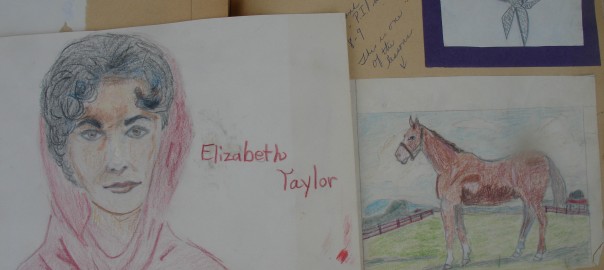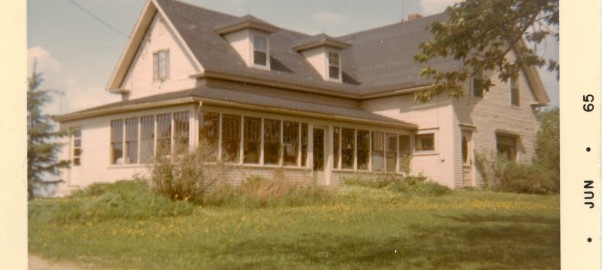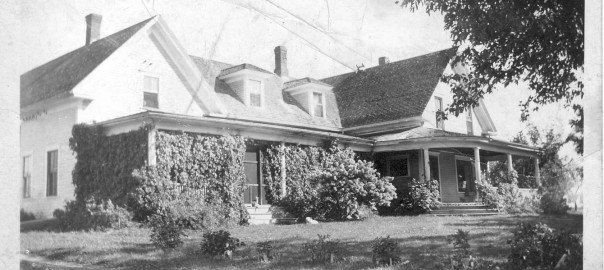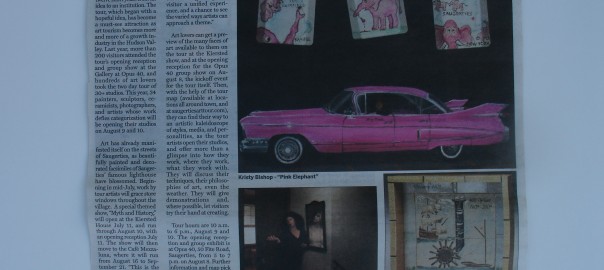My grandmother, Izah Clark died when I was 7 years old. All the other grandparents died before I was born. I remember sitting in the bathtub of water with the door locked – crying my eyes out after I got the bad news. My mother was on the other side of the door. She tried to comfort me by saying, “Grammy was tired of living…” She was sleeping in our den on the first floor of our house right up until she died. The doctor came to our house to attend to her. She wanted to be with my mother. I wish I could tell you that I knew Grammy well because she babysat for my sister Vicki (18 months younger) and I often. All I have are photos of her with us when the family was at our camp at Cross Lake and at our homestead on Forest Avenue in Fort Fairfield, Maine. Grammy never smiled in photos. She had a natural downturn at the corners of her mouth which was present in her youth as well. All I remember is her quiet presence. I am told that her false teeth did not fit properly near the end of her life and an irritation caused cancer in her mouth. She had an operation in Portland to remove it and had skin taken from her thigh to fill the hole in her jaw but the procedure was not successful. She had dementia near the end of her life, too.
“Aunt Josie,” a relative of Grammy, took care of her after the operation in a huge white Victorian home on Forest Avenue in Portland, Maine before Grammy came to live with us. Mom took Vicki and I to see her often. My two brothers, Hollis, aged 14 and Jerry, 16, stayed home with Dad. It was a three hour drive to Portland from Fort Fairfield which seemed like an eternity to us children. We played “cemetery” on the way there and back. The person with the highest count of animals on her side of the car at the destination was the winner. If we encountered a cemetery, it would mean that we lost all animal counts up to that point and had to start all over again. We sat in the back seat as mom drove the new Buick southward. When we arrived at Aunt Josie’s home, it was very close to the street. Mom told us that we could play on the sidewalk up the telephone pole at one end of the property. Forest Avenue in Portland was residential and a busy with diesel trucks roaring by often that exuded black clouds and fumes. The trucks were big and scary looking and I associated the terrible smell with cities and suffering. When Vicki and I were not running back and forth, counting the squares on the walk or visiting Grammy’s bedroom – we shopped in the “big city” of Portland. Coloring books and a box of 64 crayons gave the young artist in me a thrill! Aunt Josie’s spinster sister asked if she could color a page and I said yes; although, she didn’t do a very good job as I recall. That house was very much like the place I called home on Main Street, Saugerties for 38 years (September 1975 – February 2014).
Izah’s husband Richard Clark built a home and barn and chicken coop on the Conant Road (about 2 miles from town) in Fort Fairfield and in 1898, their first born Loomis arrived. Their claim to art appreciation was an authentic Tiffany lamp over the dining room table. In 1907, Izah’s sister Eva died of a heart attack during childbirth, so Izah took “Little Eva” as if she were her own. She came home from the hospital in a small shoe box – a “blue baby” as she was called at that time because of birth complications. Eva’s husband, Orrin Bishop, City Manager of Presque Isle was not able to care for Little Eva but had her at his home every weekend when she was older. Later, in 1916, in Izah’s “change of life” period, my mom Kathleen was born during Loomis’s High School graduation ceremony – needless, to say, he didn’t have his parents in the audience. Little Eva was plagued with a weak heart, had several heart attacks and passed away at age 15 in 1922. Loomis left Aroostook County to pursue his dreams in California and landed a great job as an accountant for a big firm. He had his own office with a secretary as well. Many letters were written to Kathleen and Loomis sent her many precious gifts over the years during her youth.
The potato farming business, managed by my astute grandmother and my hard-working grandfather was very successful. My grandmother churned butter and collected eggs to sell at the market in town every week. “Firefly” a spirited and beautiful horse was harnessed to a sleigh and took the family to town in all seasons. (She once told my mom that she wished she had more time to spend with Kathleen as a child so they bought her a pony and a dog to keep her occupied. Izah worked many long hours as well as her husband who I am told had a short temper. He left for Michigan every winter to work as a lumber jack. In the winter of 1922, Kathleen nearly died of Diphtheria but God let her live – she said in her memoirs.) They lived next to Richard’s brother, Blanchard and wife, Laura Ashby Clark, whose son and daughter, Don and Ruth were artists. As a little girl, my mom visited her artist cousins often to see their oil paintings on her way home from the little school house in neighborhood. Kathleen acquired a love of art and the smell of paints during these early years. Don and Ruth had attended the prestigious art school in Boston, the Massachusetts College of Art where Ruth graduated. To say the least, Don and Ruth Clark were “the talk of the town!” (More on that later…) Potato farming was big business at the turn of the century in Aroostook County and continued for generations. In 1926, my grandparents sold their farm to Harold Conant to buy a larger one on Forest Avenue, 3-4 miles from town. (Harold got the Tiffany lamp, too!) My mom was 10 years old at that time.
As seen in the previous photo, the house was large and an accompanying barn was even bigger. There was granary and hen house on the property as well. My grandmother cooked three big meals a day for her husband and his hired man who lived in a separate part of the house. Little Kathleen remembered how her mom made bread and desserts everyday. She loved her pony, her pets, the apple orchard, a huge white rose bush, honeysuckle as well as rhubarb, strawberries, hazelnuts and many other flowers on the property. She wrote in her memoirs that she had a happy and exciting life – especially her childhood. She remembers waking up in the night and feeling so blessed that she had such good parents and such a safe environment. “I thank God that I was so lucky,” she wrote. Her memoirs of childhood have been published in “Fort Fairfield: Its Time to Tell our Stories 1858 – 2008” Frontier Heritage, editors Rayle Reed Ainsworth and Sarah Ulman, 2008. ( I promised to have them published as well as some of my own in a book. Mom passed away a year before it was done; but somehow, I think she knows.)
The bottom fell out of everything in 1929 – the Stock Market crashed. My grandparents lost all of their savings in the bank. Money for Kathleen’s college tuition was gone. Grammy asked Loomis to come home to help with the farm. (Rumor was that Loomis was enjoying too much of the “high life” in California anyway.) He returned and taught Kathleen, aged 14, how to drive a stick shift vehicle and immediately, she got her license for $2 (no test required.) The family rallied financially and for Kathleen’s graduation present in 1934, she received a brand new Lafayette car. She toyed with the idea of going to hair-dressing school but began dating instead. (Evidently it was a full time job! ) My dad remembers seeing her driving that fancy car around town and it was love at first sight – at least this is my idea of it and it was her, not the car, of course!!) In the meantime, Loomis married a local girl and they made their home at the homestead in the servant quarters. Loomis was gifted at drawing and Kathleen remembers a picture of Christ that he drew which remained in her mind for the rest of her life. She also remembered that Loomis had a drinking problem and his marriage failed. He died in 1940 at age 42 of pneumonia in the Bangor Hospital after getting sick on a train ride between Fort Fairfield and Boston.
My father George Bishop married Kathleen Clark at her homestead on Forest Avenue, Fort Fairfield on June 29, 1938. She was 24 and he was 26 years old. He had been farming with his dad, Percy Bishop and mother, Lou Lou Harmon Bishop on their farm in Green Ridge (on the other side of town) and there was a small house on the property where they could live in the beginning. In 1940, they were chosen as “Typical Maine Farm Couple” a distinguished title since many couples in Aroostook County were nominated with the opportunity to win this position. They traveled to Springfield, Massachusetts to reign as the Jubilee King and Queen of the Potato Industry at the Eastern States Exposition. My father was interviewed on public radio and spoke intelligently of how he managed his crops (I have the transcript) and Kathleen was quoted in the Boston Globe how she faired as the wife of a successful farmer. Unfortunately, she was misquoted to make the article entertaining, but she was a stunning beauty so the photos of her made up for the mistakes in the article. My father was considered a handsome man – I have a huge scrapbook of newspaper photos and write-ups of the entire event where they were honored right along with famous celebrities of the day.
At that time, my maternal grandparents rented land to my father for the use of raising potatoes and after my grandfather died of a heart attack in 1944, Izah gave the farm to Dad and Mom. She said, “You have paid enough rent!” She bought a home in town on Elm Street where she could walk to the grocery store and to church. She was not interested in driving the Hudson Trail Blazer that her husband loved. My mother recalls her mother’s beautiful flower gardens in town – a love that was passed on to my mom but the tending of such did not appeal to me as a child and all through my life so far. Instead, I want to paint pictures of them!
Finally, the color pink was (sort of) a thorn in my father’s thigh since the time that my mother chose the color for all the buildings on their property during the 1950’s. It was supposed to be beige but when it dried it appeared more pink than beige. Early on, Dad had torn down the tall barn and built a long and large modern barn to house his many tractors, trucks and farm equipment and a stable for pleasure horses at one end. His hired man, Keen Haines helped him build a three car garage and a house for the harvest crew that came every fall to pick potatoes. The top section of the granary was used to house the rest of the crew. Previously, Dad had bought three more farms which had plenty of buildings on each one, 450 acres of tillable rich soil to plant crops and raise cattle and hogs, too. The animals were gone by the time I entered elementary school and all of the equipment was replaced with the most modern available. When I was little, I used to sit on the backs of some of the cows and Dad told me that he got too attached to them to continue that part of the business. My older brothers each owned a pleasure horse and I wanted one…at age 4 and 5, I drew pictures of me on a horse (still have one of those drawings) and I rode the saddles on a wooden rack (built by Dad) the size of a horse in the barn…more on that subject of horses later.
We went on many vacations and when we returned the pinkish-beige buildings were a welcome sight to me. When we turned off the Houlton Road onto the Cross Road of Forest Avenue- the sight of many pink buildings in the distance thrilled my heart. It was my favorite color all through childhood!



